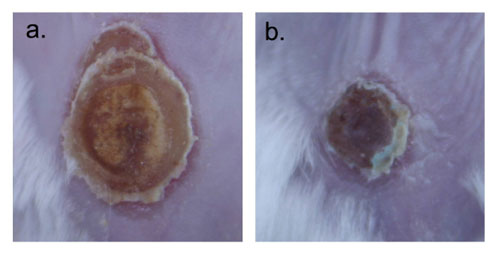BY CHRISTOPHER VAUGHAN - Building on previous research showing that cancer cells send signals to the immune system to avoid being attacked, Stanford scientists have engineered new molecules that are highly proficient at neutralizing those signals.
Christopher Garcia
The molecules dramatically increase the effectiveness of certain existingcancer therapies and may open up other avenues for treating cancerusing patients' own immune systems.
School of Medicine researchers have previously shown that CD47, a molecule found on the surface of many cancers, acts as a "don't eat me" signal that protects the cancer from roving immune cells called macrophages. The scientists found that when they used drugs to block this "don't eat me" signal, macrophages engulfed and destroyed the cancer cells.
More recently, Stanford scientists wondered if they could engineer molecules that block the signal more effectively. They began by modifying a protein called SIRP-alpha, which is found on macrophages and is the natural receptor for CD47. In a paper published online May 30 in Science, a team of scientists working with professors Christopher Garcia, PhD, and Irving Weissman, MD, report that they have engineered new versions of SIRP-alpha that bind much more strongly to CD47 than the natural version of the molecule, making them extremely potent blockers of the "don't eat me" signal.
Two MD/PhD students in the Stanford Medical Scientist Training Program — Kipp Weiskopf, MPhil, and Aaron Ring, MS — devised the strategy for engineering these new molecules and were lead authors of the Science paper.
"This is the best example of how science and medical trainingcan lead to discovery and medical translation," said Weissman, professor of pathology and of developmental biology. "Weiskopf and Ring fleshed out the ideas that led to this project, bringing the complementary expertise of our groups together."
The engineered SIRP-alpha variants bind approximately 50,000 times more strongly to CD47 than native SIRP-alpha, making them highly potent drugs, Weiskopf said. But the researchers found blocking the CD47 "don't eat me" signal is not, by itself, enough to stimulate macrophages to attackcancer cells. Instead, the group demonstrated that blocking CD47 boosts the activity of macrophages when a second "eat me" signal is provided. This signal can be provided by certain anti-cancer antibody therapeutics, many of which are already approved by the FDA and in use clinically.
These findings have tremendous therapeutic implications, Ring said, because the high-affinity SIRP-alpha molecules could selectively boost the destruction of cancer cells by these antibody therapies, without increasing toxic side effects such as the destruction of healthy, non-cancerous cells.
The authors found that their engineered SIRP-alpha molecules would enhance a number of widely used antibody therapies such as rituximab (which targets certain lymphomas and leukemias), trastuzumab (which targets certain kinds of breastcancer) and cetuximab (which targets certain kinds of head and neck cancer and colon cancer).
When physicians used an anti-cancer antibody like these to fight cancer, the antibody's "eat me" signal to the macrophage is fighting against the cancer's "don't eat me" signal coming from the CD47, the researchers explain. When the high-affinity SIRP-alpha binds tightly to the CD47 molecules on the cancer, it takes the brakes off the macrophage attack on the cancercells.
"When physicians use an anti-cancer antibody like trastuzumab to fight breast cancer, the 'don't eat me signal' from CD47 on the cancer limits the effectiveness of the antibody," said Ring. "Potentially, any anti-cancer antibody that stimulates immune cells could benefit from this combination therapy."
In one experiment, when either rituximab or the high-affinity SIRP-alpha variants were used by themselves on mice with human lymphomas, they were only able to slow tumor growth. However, when the two therapies were combined, researchers found they were able to eliminate the tumors completely. "Antibodies are like guided missiles in terms of targeting cancercells," Weiskopf said. "By combining them with the high-affinity SIRP-alpha variants, you are adding high-explosive warheads to those missiles ."
The researchers hope that their work with high-affinity SIRP-alpha molecules will lead to more effective targeted-cancertherapies in the clinic. "This work further validates the strategy of targeting CD47 to enhance macrophage attack of cancer," according to Weissman. "This strategy must still be tested in humans to evaluate safety, but anti-CD47 antibodies are on schedule for the first trials in patients next year."
Other authors of the paper include graduate student Chia Chi M. Ho; instructor Jens-Peter Volkmer, MD; former postdoctoral scholar Aron Levin, PhD; postdoctoral scholars Anne Kathrin Volkmer, MD, Engin Özkan, PhD, and Nathaniel Fernhoff, PhD; and Matt van de Rijn, MD, PhD, professor of pathology.
![[Source: Broad Institute]](http://singularityhub.com/wp-content/uploads/2013/05/image2A6.jpg)
![Nano-networks of porous beads are engineered to respond to high levels of blood sugar by releasing insulin. [Source: Journal of Agriculture and Food Chemistry]](http://singularityhub.com/wp-content/uploads/2013/05/nano.jpg)


 Images
Images